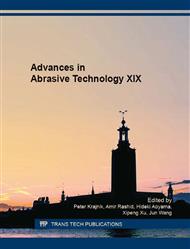p.22
p.28
p.34
p.40
p.46
p.52
p.59
p.64
p.70
Effects of Cutting Atmosphere on High-Speed End Milling Process for Titanium Alloy Ti6Al4V
Abstract:
As titanium alloys have a high strength-to-weight ratio and superior corrosion resistance, they are widely used in the aerospace, biomedical, and automotive industries. However, these alloys exhibit very poor machinability, which results in problems such as short tool life. This study investigates the effect of the cutting atmosphere on tool wear during high-speed end milling of the titanium alloy Ti6Al4V. Dry cutting, cold air jet cutting, cutting fluid mist jet cutting, and cutting fluid flush cutting were considered in order to determine the optimum cutting atmosphere and conditions. For down-cutting speeds of 200−300 m/min, the cutting atmosphere and cutting speed were adopted as experimental parameters. Down-cutting was performed in order to measure the width of the tool flank wear land as the cutting length was increased. The results indicated that the optimum cutting method was cold air jet cutting. For a cutting length of 500 mm, this method produced a narrower flank wear land than dry cutting. In addition, for longer cutting lengths of up to 4000 mm, the wear rate for cold air jet cutting was less than or equal to that for dry cutting, and no chipping or excessive wear was observed.
Info:
Periodical:
Pages:
46-51
Citation:
Online since:
October 2016
Authors:
Keywords:
Price:
Сopyright:
© 2016 Trans Tech Publications Ltd. All Rights Reserved
Share:
Citation:


